|
McCloud River Railroad
Equipment Roster All Door Boxcars |
|
|
Lumber has traditionally been moved either in box cars or on flat cars. Box cars have an advantage in that the loads are completely enclosed and protected, but have a real disadvantage in that they are difficult to load and unload, as all lading has to pass through the doors in the side of the car. Flat cars are extremely easy to load and unload, but offer no protection to the loads. Then McCloud River Railroad president Flake Willis spent considerable time in the early 1960s pondering various solutions to the "boxcar problem" and came up with at least two designs to ease boxcar loading and unloading. One was for an open topped car that would somehow make rail service cost competitive with trucks for lumber from the McCloud region destined to California markets that apparently never got any traction, but his other idea sparked a relatively short lived revolution in lumber transport technology. In 1962 a vice president of International Car delivered McCloud River's two new cabooses (#101 and #102) to the road in person. The vice president went to lunch with railroad president Flake Willis. Over lunch Mr. Willis complained about the inadequacies of common boxcars for lumber loading purposes and sketched out on a napkin the basic plan for a new type of car that would offer the same load protection characteristics of a boxcar combined with the ease of loading/unloading characteristics of a flatcar. The plan featured a fixed floor, ends, and roof, with the car sides composed of four large sliding doors that could give full loading access to half of the car at any given time, depending on the positioning of the doors. The Southern Railroad had pioneered a variation on this concept several years earlier, but their design used roll-up jointed doors similar to a garage or storage shed instead of the single piece sliding doors of Flake's design. The idea intrigued International, who built the prototype car in the summer of 1962. |
|
|
|
IRCX 4501/PLYX 1000/MR 1000 International built the prototype car for Morrison Plan, Inc., their corporate parent, in the summer of 1962. Morrison leased the car to the McCloud River Railroad for a period of five years, with rental fees set at $5 per day. International painted the car a dark green color with a yellow stripe down the side, IRCX lettering, and a MR logo. U.S. Plywood purchased the car at the end of the lease, painted the car a flat olive green, and lettered it PLYX #1000. The car served U.S. Plywood for a few years; however, by the end of the 1970s the car sat derelict in the McCloud yard. U.S. Plywood sold the car to the McCloud River Railroad in 1977, which promptly converted the car to flat #1000. 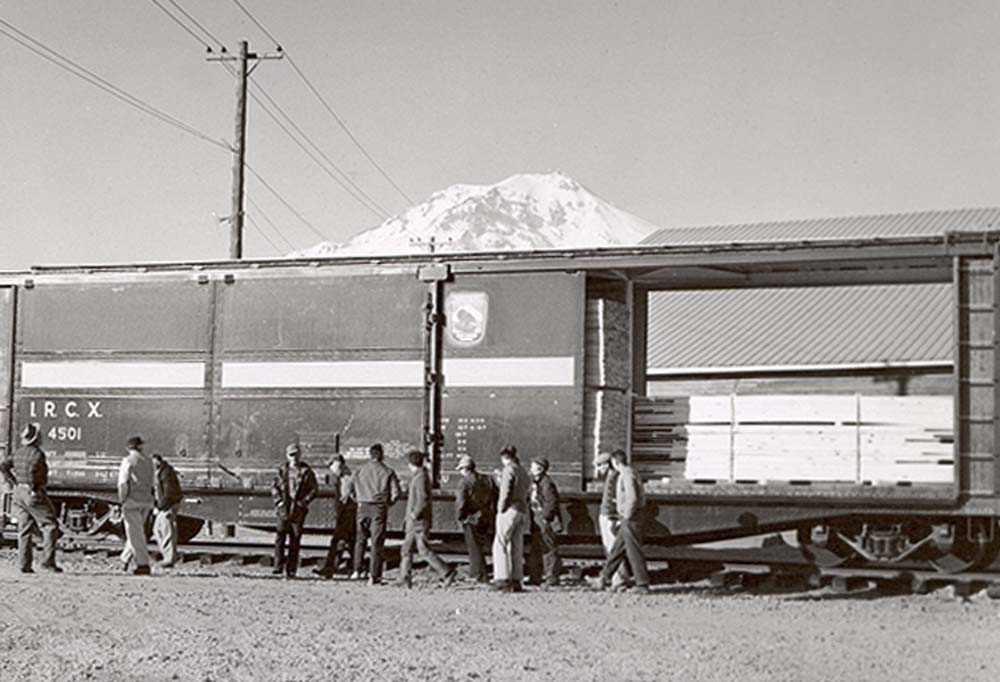
The prototype all-door car is being loaded with lumber in McCloud. Travis Berryman
collection. 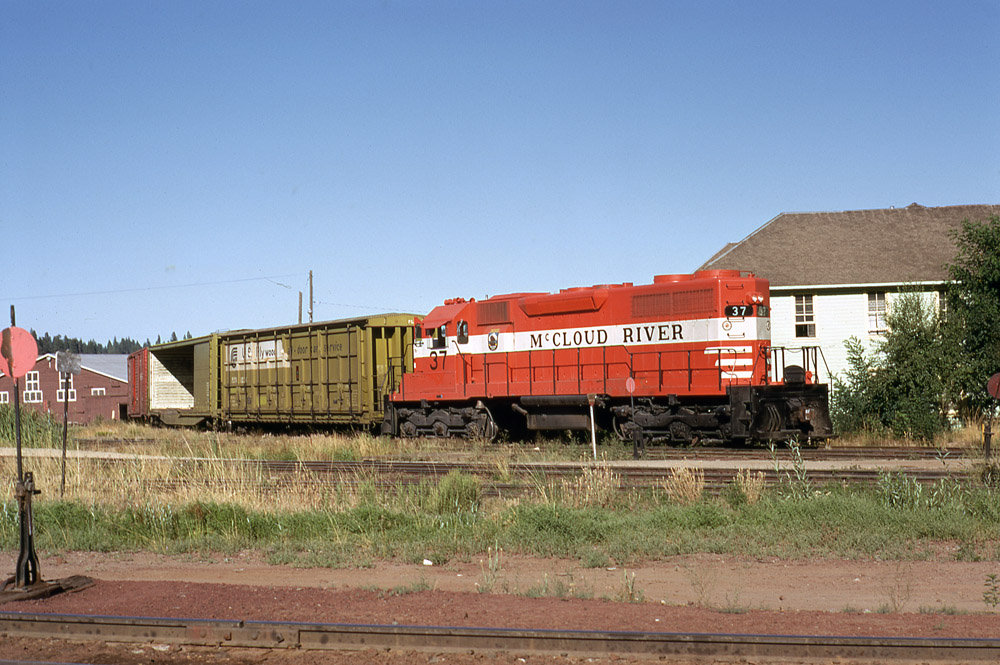
The prototype all-door car after being sold to U.S. Plywood being switched in McCloud by the #37 in October 1969. Keith E. Ardinger photo. 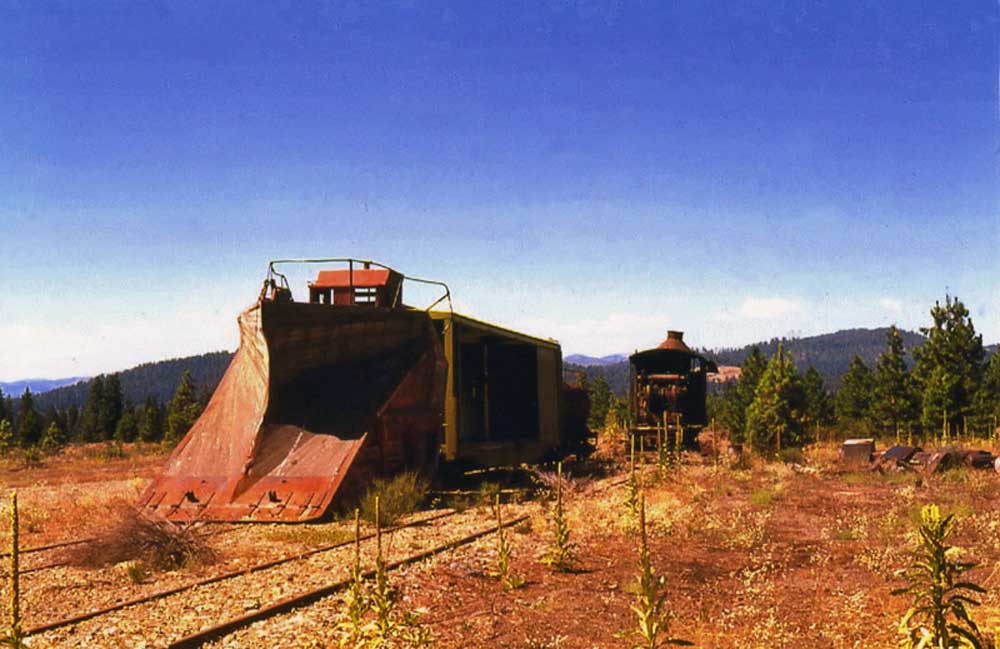
The #1000 stored derelict with some other equipment at Ash Creek Junction. Dennis Sullivan collection. 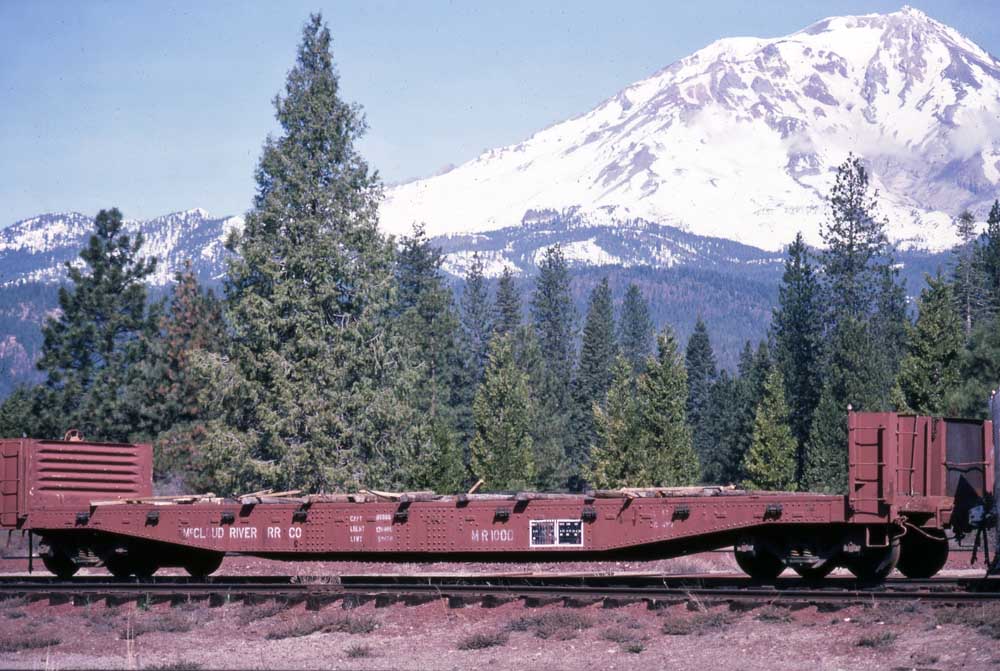
Flat car #1000 after it has been cut down from the all-door boxcar. Jerry Lamper photo. |
|
|
|
PLYX 1000-, 1200-, 1400-, and 1600- series The concept for the all-door boxcar caught on quickly with the lumber industry, and with a few short years several manufacturers were building cars based on Flake's design. Lumber companies themselves tended to own or lease these cars instead of railroads, as they could control the use of the cars to benefit them in ways common carrier railroads could not, and from the late 1960s through the early 1970s there were very few major lumber manufacturers that didn't have at least a few of these cars lettered for their concerns. Despite originating the concept, the McCloud River Railroad waited until the lease on the prototype car was either at or near its expiration before placing an order for fifty cars with Thrall, one of the major railcar manufacturers that had started building all door boxcars. The order cost the company a million and a quarter dollars, financed by the Marine Midland Grace Trust Company of New York. However, before the cars could be delivered, U.S. Plywood assumed the order through their subsidiary Plycar Corporation. Plycar leased the cars back to U.S. Plywood through a lease signed on March 1, 1967. Plycar placed a second order for another set of fifty cars with Southern Iron Works sometime in the spring of 1967. Thrall built the first fifty cars in March 1967. U.S. Plywood numbered this first set of cars in the 1400- and 1600-series numbers, as follows: 1410, 1412, 1414, 1416, 1418, 1430, 1432, 1434, 1436, 1438, 1450, 1452, 1454, 1456, 1458, 1470, 1472, 1474, 1476, 1478, 1490, 1492, 1494, 1496, 1498, 1610, 1612, 1614, 1616, 1618, 1630, 1632, 1634, 1636, 1638, 1650, 1652, 1654, 1656, 1658, 1670, 1672, 1674, 1676, 1678, 1690, 1692, 1694, 1696, and 1698. Southern Iron Works built the next fifty cars in November and December of 1967, with U.S. Plywood numbering those cars into the 1000- and 1200- series as follows: 1010, 1012, 1014, 1016, 1018, 1030, 1032, 1034, 1036, 1038, 1050, 1052, 1054, 1056, 1058, 1070, 1072, 1074, 1076, 1078, 1090, 1092, 1094, 1096, 1098, 1210, 1212, 1214, 1216, 1218, 1230, 1232, 1234, 1236, 1238, 1250, 1252, 1254, 1256, 1258, 1270, 1272, 1274, 1276, 1278, 1290, 1292, 1294, 1296, and 1298. The cars suffered through some initial teething problems. ICC inspectors almost immediately red tagged all of the Thrall built cars for bad door stops, which Thrall corrected at one of their plants in Chicago. The cars also seemed to get into more than their share of wrecks in the first years, with sideswipes being the most common affliction. 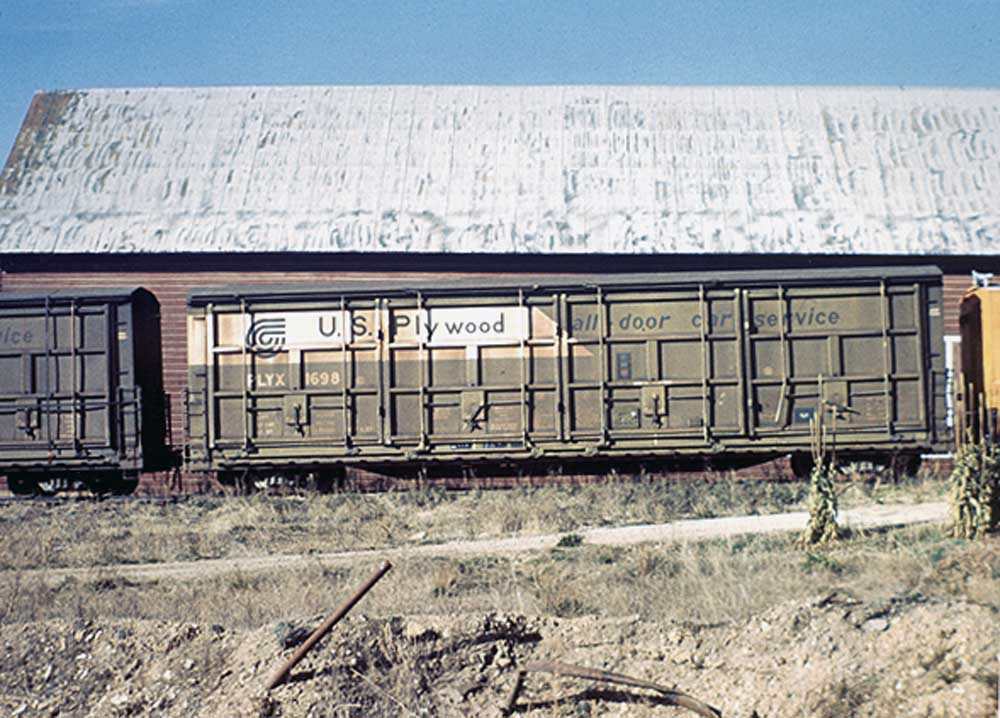
PLYX 1698, one of the Thrall built cars, models the olive and cream paint scheme the cars wore. Travis
Berryman collection. 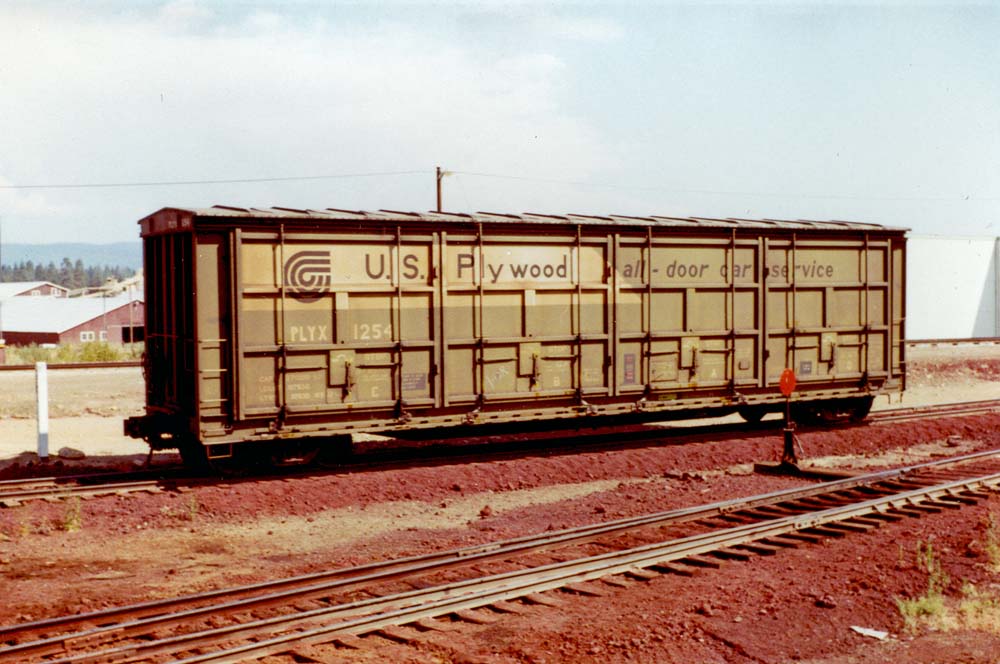
PLYX car #1254, built by Southern Iron Works, in front of the shop. Jeff Moore collection. 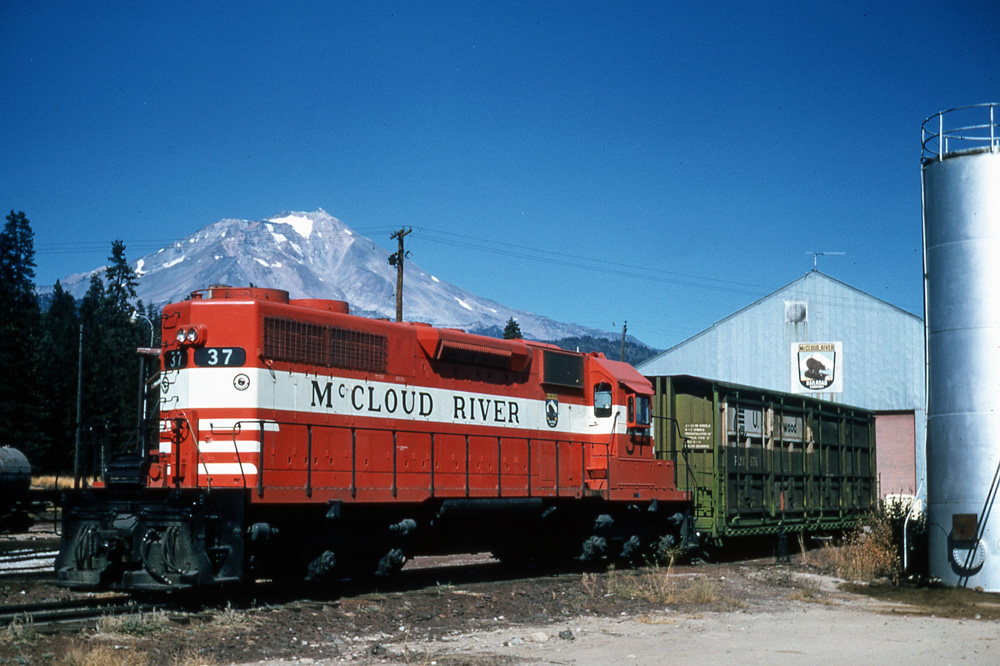
The #37 switching a Thrall built car in McCloud. Some of the differences between the car shapes and ends can be seen by comparing this photo with the #1254 above. Jeff Moore collection. 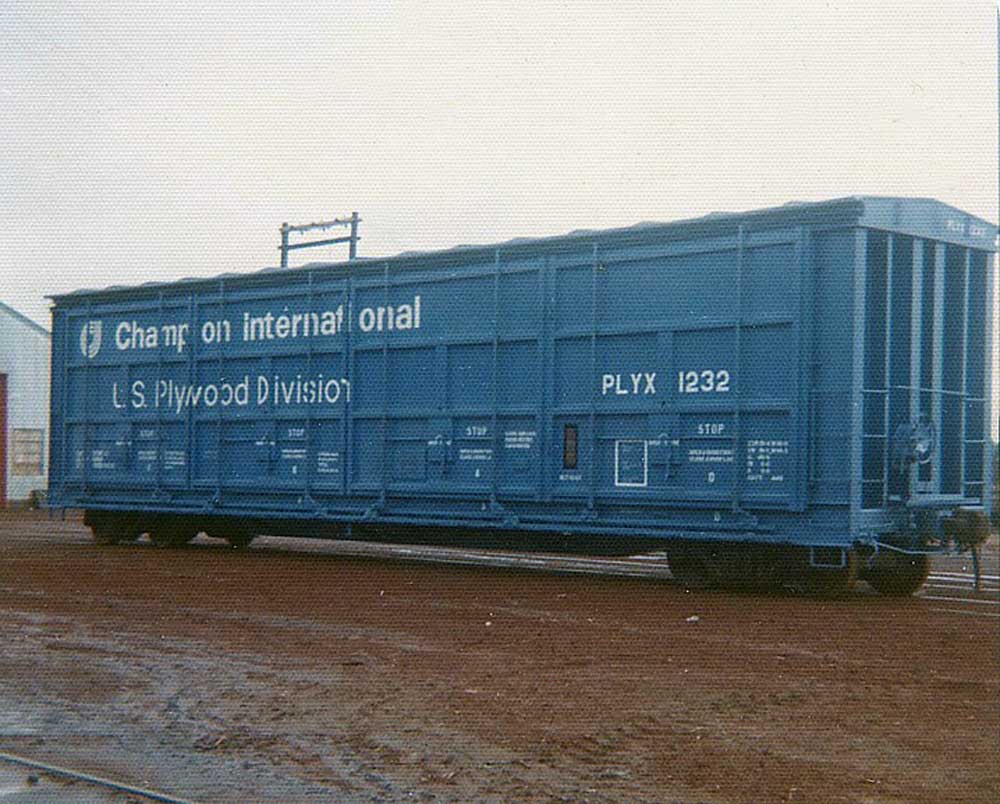
Champion International re-painted at least one of the Southern Iron-built cars into this blue scheme after
acquiring U.S. Plywood. However, most of the fleet kept the original colors until the end. This photo gives
a bit of a better view of the car ends of this series.
Photo by and courtesy of George Landrock.
|
|
|
|
MR/MCR 1000-, 1200-, 1400-, and 1600- series The all door boxcar enjoyed only a relatively brief period of populatiry in the lumber industry before being eclipsed by evolving technologies. One of the biggest factors in their demise was a fairly rapid shift in lumber manufacturers from shipping individual lumber boards to wrapped unitized bundles that better protected the lumber and allowed expanded use of the larger bulkhead flatcars then coming into existence. The many moving parts on the all door cars also added to their maintenance needs and costs, and as these mounted the cars tended to quickly fall out of favor. The U.S. Plywood fleet was not exempt from these trends, and by the middle 1970s the cars spent most of their time sitting idle in the McCloud yards. Champion International sold the remaining 94 cars to Itel at the same time that company also purchased the McCloud River Railroad. Itel immediately set out to rebuild the cars into standard boxcars, which would both provide the company with investment tax credits and make the resulting cars eligible for incentive per diem rates. The work is said to have been done by FMC in Portland; if so, the doors removed from McCloud made their way back to McCloud, where they were stored until scrapped in the early 1980s. A few of the removed doors survive as part of a loading ramp at Ash Creek Junction. McCloud River Railroad did buy the #1452, which it converted to work flat #1001:2. The cars saw some service in the nation's rail network in the late 1970s, but their oddball nature meant they were among the first cars idled as the incentive per diem boxcar markets imploded. By the early 1980s all of the cars were in storage at various places around McCloud. The cars saw relatively little use on the railroad afterwards, with their primary chores being to haul bagged diatomaceous earth from the Dicalite reload and occassional lumber shipments from P&M Cedar after they reopened the McCloud mill. The McCloud Railway purchased the surviving cars shortly after acquiring the rest of the property. A few of the cars saw service in the first years of that company; however, by the late 1990s the shop was in the process of scrapping all of the cars, with the last one cut up by 2004/2005. Cars in this series numbered 94 through 1995; 60 cars in 1996; 3 cars in 1997; and 1 car (MR 1058) surviving until 2007. The railroad sold most of the frames for use as bridges and converted many of the bodies into sheds, with most of them in McCloud at the shop and one each at Ash Creek Junction and Bear Flat. Carlton Trucking in Burney purchased several bodies that they incorporated into a truck shop. The railroad retained one frame for use as a maintenance flat until the fall of 2011, when they scrapped it as well. The Williams Group subsequently scrapped all of the bodies used as sheds around the shop in the fall of 2013. One intact car- MR #1236- survives in the collection of the Western Pacific Railroad Museum in Portola, California. 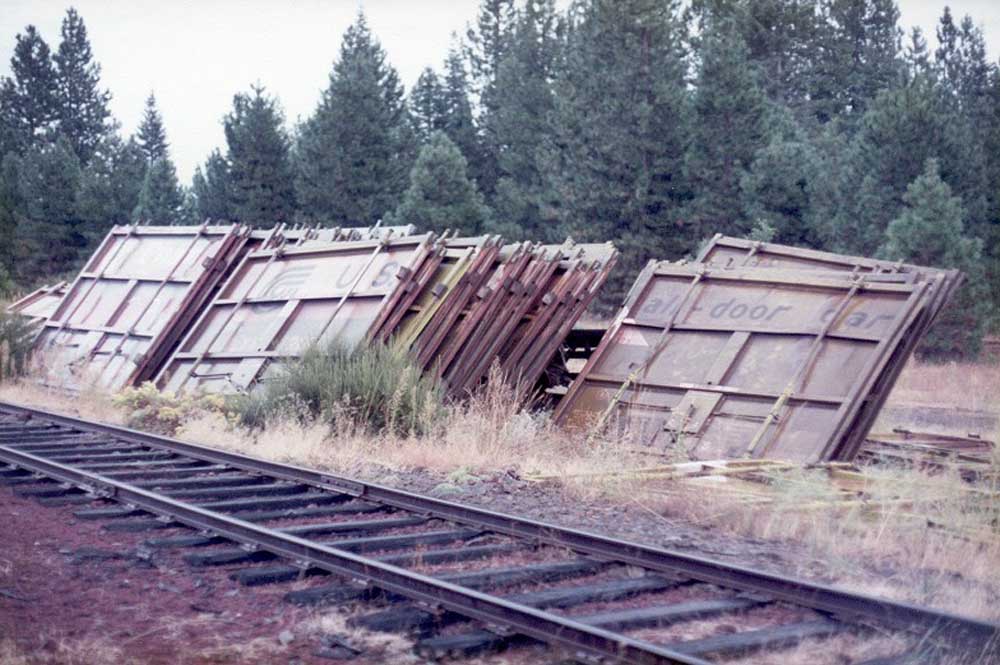
Doors removed from the ex-U.S. Plywood all-door boxcars converted to McCloud River boxcars are
seen here piled at Ash Creek Junction east of McCloud on 17 Sept 1982. Photo by Jimmy Bryant,
courtesy Nevada Historical Society. 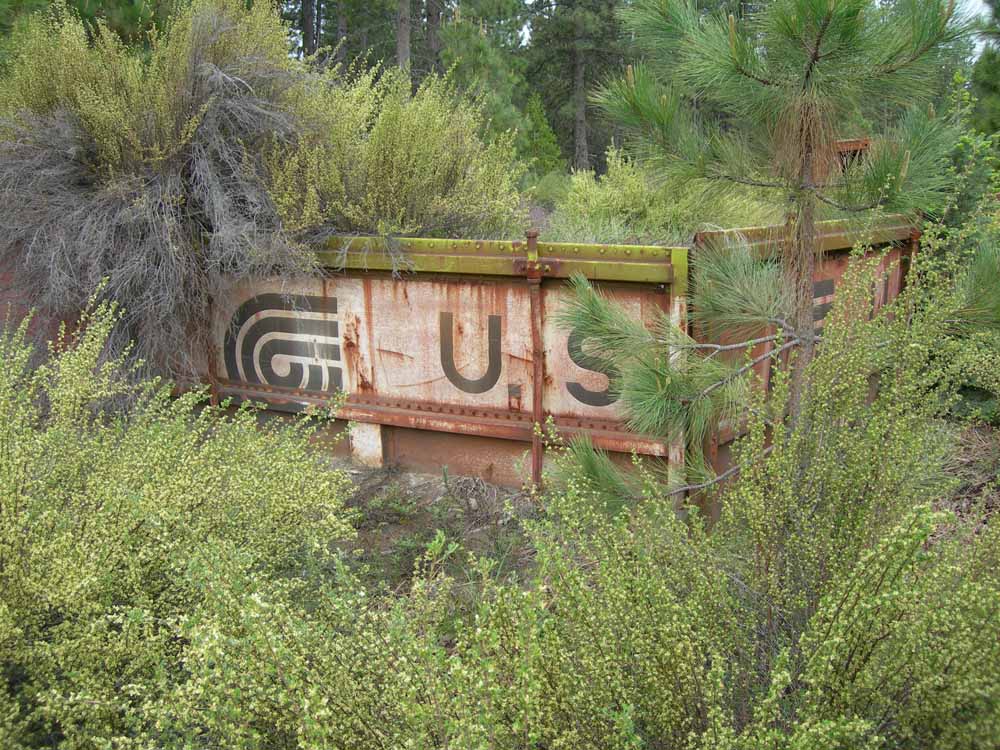
Most of the doors removed from the US Plywood rebuilds during the re-build process were scrapped.
However, the railroad used several to build an earthen loading ramp at Ash Creek Junction. Jeff Moore
photograph. 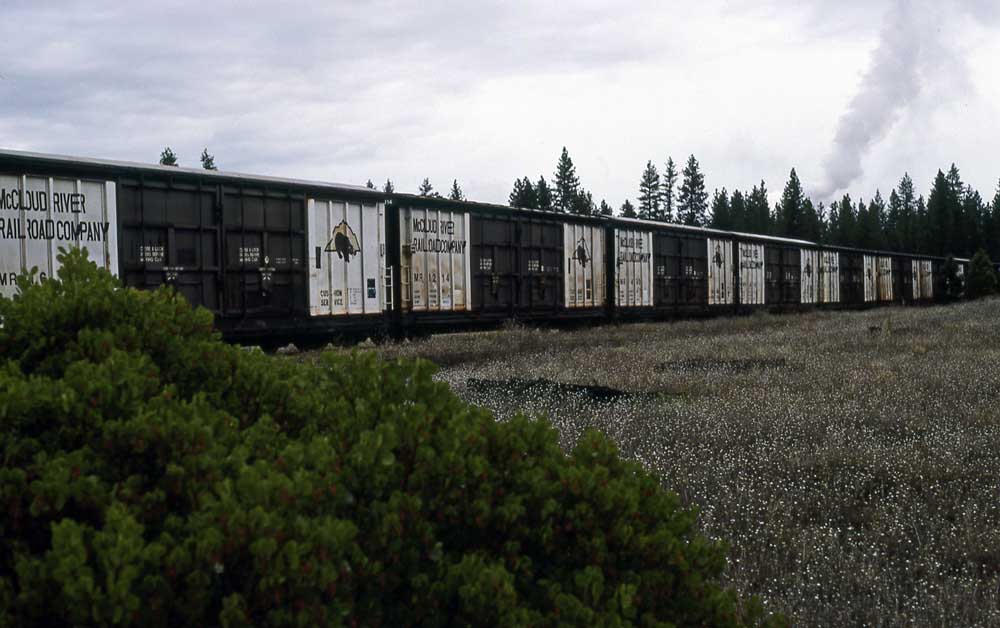
Boxcars rebuilt from all door cars in Burney in November 1984. Steve Moore photo. 
The former all door cars featured a substantially darker brown and a smaller logo than the new incentive per diem boxcars. Steve Moore photo. 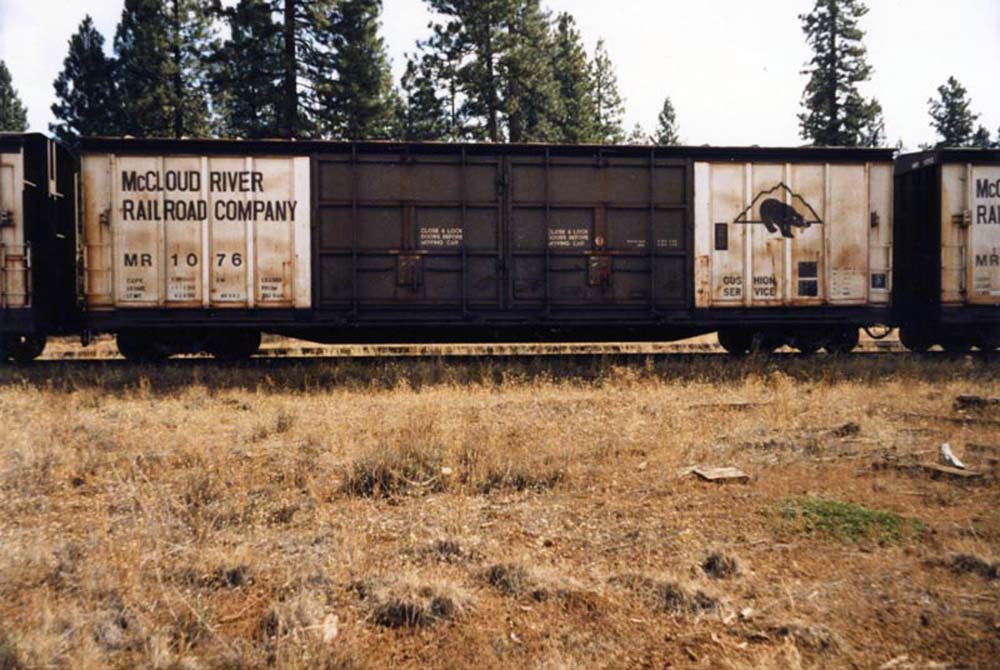
MR #1076, formerly PLYX 1076, in Burney. Pat Driscoll photo, Jeff Moore collection. 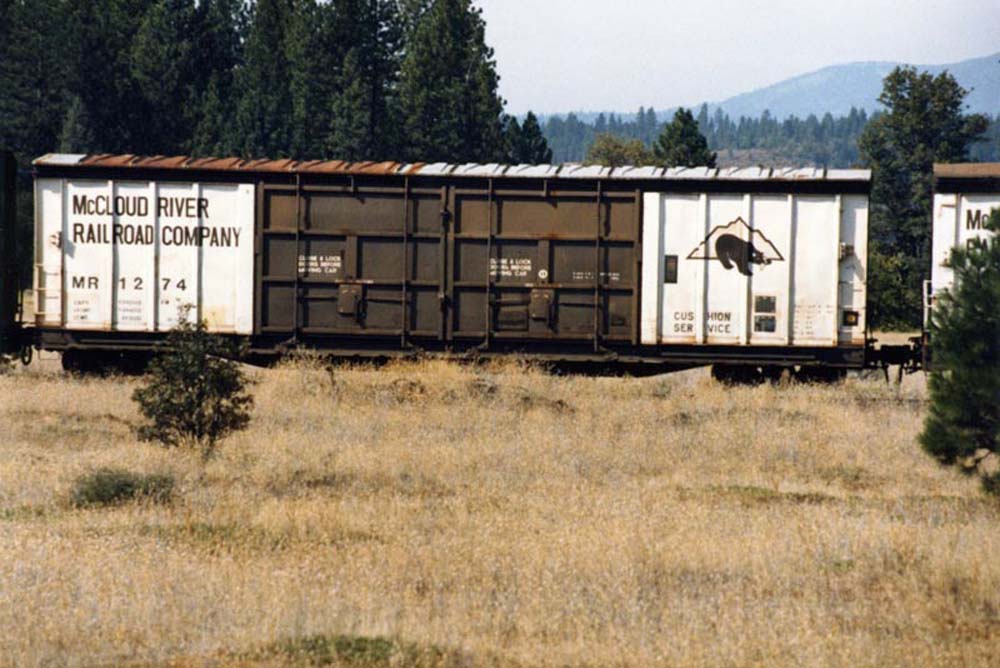
MR #1274, formerly PLYX 1274, in Burney. Pat Driscoll photo, Jeff Moore collection. 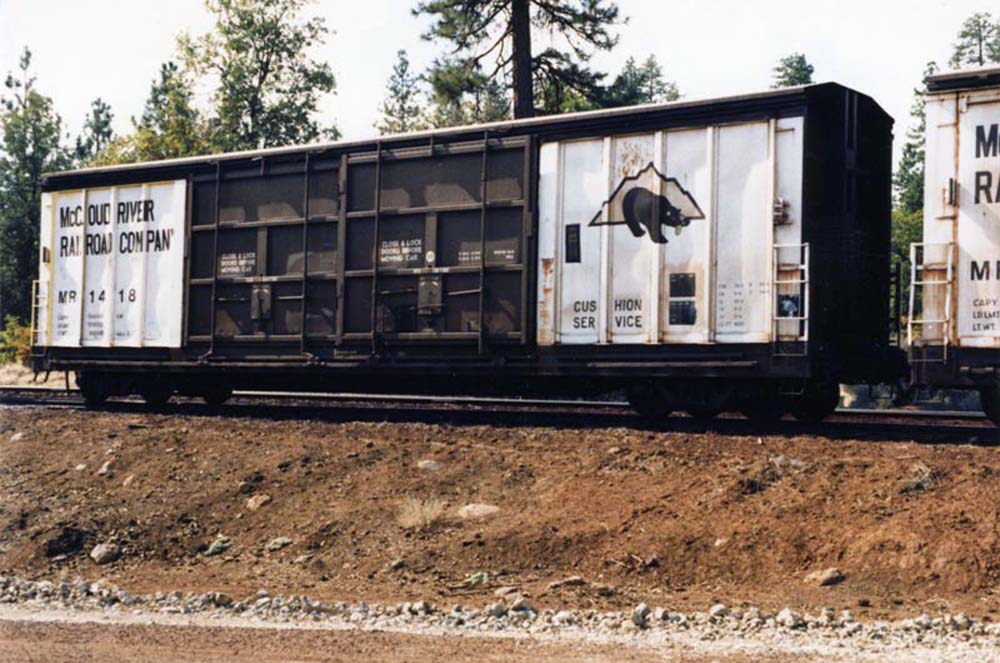
MR #1418, formerly PLYX 1418, at Cayton. Pat Driscoll photo, Jeff Moore collection. 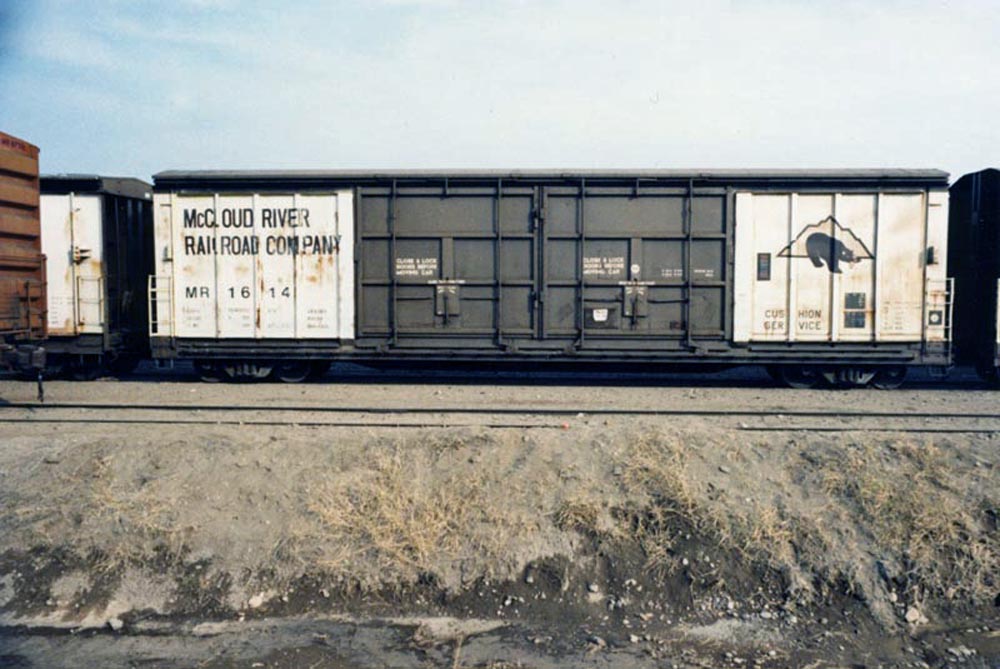
MR #1614, formerly PLYX 1614. Pat Driscoll photo, Jeff Moore collection. 
A McCloud Railway all-door car being loaded by P&M Cedar Products in McCloud. Lee A. Christopher
photograph. 
Portola, CA, 7/2011. Former McCloud River Railroad #1236 at the Western Pacific
Railroad Museum, Portola, CA. 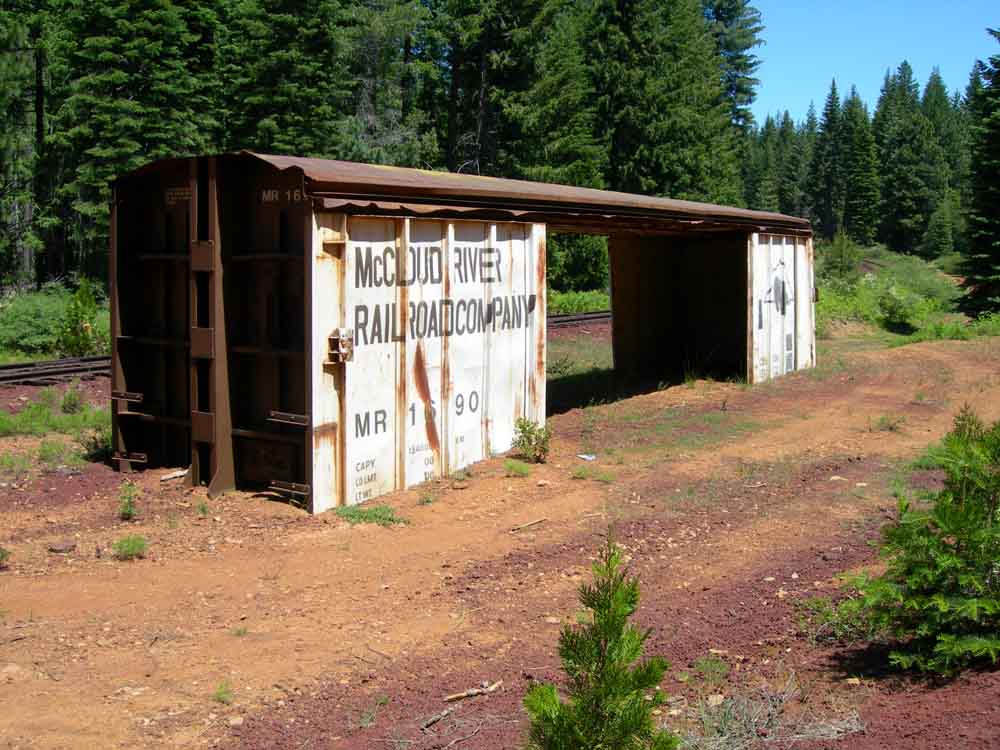
The body of MR #1690 in use as a section shed at Bear Flat. |
|
|